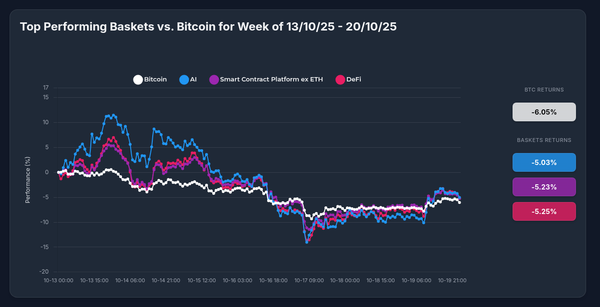Why Is Liquidity the Only Crypto Signal That Matters Right Now?

What if the recent crypto crash wasn't random chaos, but a liquidity warning signal?
As we close October 2025, the crypto market stands at a critical inflection point. While institutional adoption reaches record highs and major ETF launches signal mainstream acceptance, the macroeconomic backdrop tells a different story—one of tightening liquidity that investors ignore at their peril.
The Big Picture: Liquidity Is Contracting
Central Thesis: Crypto markets respond to liquidity flows, not narratives. Despite positive institutional developments, deteriorating fiscal flows and slowing credit creation in major economies signal caution ahead.
What Happened in October 2025
Crypto Market Developments
- October 10-12 Deleveraging Event: Over $19 billion in leveraged positions liquidated. Bitcoin dropped 14% to ~$104,782, Ethereum fell 12%, with some altcoins plunging 40-70%. This wasn't random—it was a liquidity-driven correction exposing over-leveraged positions.
- Record Institutional Growth: Q3 2025 saw crypto futures/options volumes exceed $900 billion, with 1,014 large open interest holders—the highest ever recorded.
- Spot ETF Launches: First U.S. spot ETFs for Solana, Hedera, and Litecoin began trading October 28 with $65 million in first-day volume.
- Ethereum Fusaka Upgrade: Final testnet activated, mainnet launch expected December 2025.
- Corporate Integration: Visa expanded stablecoin support; Western Union plans Solana stablecoin by 2026; PayPal-OpenAI wallet integration in ChatGPT.
The Liquidity Picture: Mixed Signals
United States:
- Fiscal Deficit: FY 2025 deficit of $1.8 trillion—historically large but $8 billion lower than FY 2024
- The Problem: Year-over-year fiscal flows are worsening. A smaller federal deficit means a smaller private sector surplus—less money circulating in the economy
- Credit Growth: Strong bank loan growth at 3-year highs (1.7% in Q2), driven primarily by loans to non-depository financial institutions
- Consumer Credit: Resilient but showing "small cracks" according to bank data
- Interest Payments: Government debt interest exceeded $1 trillion for the first time—now the second-largest expenditure after Social Security
European Union:
- Credit Growth: Subdued despite ECB rate cuts. Loan rates down to 4.2% for firms, 3.3% for mortgages
- Demand Problem: Weak loan demand persists despite cheaper borrowing costs
- Growth Outlook: Projected 0.9% GDP growth in 2025—anemic
China:
- Credit Stimulus: New loans surged to 1.29 trillion CNY in September (vs. 590 billion in August)
- Policy Response: Aggressive credit expansion to counter economic headwinds and U.S. trade tensions
- Trade Diversification: Exports to U.S. down 27% YoY, but up significantly to EU (14%), Southeast Asia (15.6%), and Africa (56.4%)
What This Means for Crypto Investors
The Warning Signs
- September Federal Surplus: The U.S. government recorded a $198 billion surplus in September—a timing quirk that represents negative fiscal flows for risk assets
- Credit Creation Slowing: Macroeconomist Alan Longbon notes credit creation dropped from ~$150B to $75B month-over-month
- Sectoral Balance Prediction: The private domestic sector balance line is trending down, historically predicting stock market weakness
The Positive Catalysts
- Institutional Infrastructure: Record futures/options activity and ETF launches create permanent infrastructure for crypto investing
- Real-World Integration: Major payment processors and financial institutions embedding crypto into core services
- Technical Progress: Network upgrades like Ethereum's Fusaka improving scalability and performance
The Investment Recommendation
Be Cautiously Positioned: The macro environment suggests near-term headwinds despite long-term structural tailwinds.
Why?
- Liquidity drives crypto prices more than adoption news. Deteriorating fiscal flows and slowing credit creation in major economies reduce the pool of capital available for risk assets.
- The October deleveraging was a warning, not an anomaly. Over-leveraged positions remain vulnerable to liquidity shocks.
- Higher interest payments drain liquidity. With U.S. government debt service exceeding $1 trillion, more money flows to bondholders but overall liquidity conditions are challenged by smaller deficits.
The Opportunity: Institutional infrastructure being built now will support the next major cycle when liquidity conditions improve. Position for that, but respect current macro headwinds.
The Bottom Line
Crypto is maturing as an asset class—the ETF launches, institutional participation, and corporate integration prove that. But maturity means greater correlation with liquidity cycles, not immunity from them.
Watch these signals:
- U.S. monthly fiscal deficits (private sector surplus indicator)
- Bank credit creation data
- China's credit impulse and stimulus measures
- Leveraged position metrics across crypto futures markets
The next major crypto bull run will come—but it requires expanding liquidity, not just exciting headlines. Until fiscal flows turn positive and credit creation accelerates, cautious positioning with selective accumulation makes sense.
At Optima Financial, we help you navigate these complex macro-crypto connections so you can invest like the top 1%.





